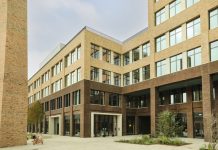Atkins, one of the world’s most respected design, engineering and project management consultancies, has been awarded a contract to help make Old Oak and Park Royal, London’s largest opportunity area, one of the most sustainable urban developments in the UK.
At five times the size of the Capital’s King’s Cross redevelopment and one of the biggest schemes of its type in Europe, the £26 billion Old Oak and Park Royal project has the ability to deliver over 25,500 new homes and the capacity for 65,000 jobs. Atkins, working with Old Oak and Park Royal Development Corporation (OPDC) and its cost and project management consultancy, Faithful+Gould, will develop a set of ambitious environmental sustainability targets that will be used on Old Oak and Park Royal and feed into all future development across London. These targets will look to improve upon the targets set out in the London Plan and Mayoral strategies.
Sean Lockie, sustainability director, Faithful+Gould, said: “Old Oak and Park Royal is a massive opportunity for London to do things that haven’t been done before. It means creating a vision which sets out clear goals, such as being healthy to live in, flexible over time, affordable, comfortable, and being energy and resource efficient, and then taking a systematic approach to delivery. We’ll need to come up with some new business models to achieve this but in doing so we have a great opportunity to make a real difference to people’s lives.”
The sustainability targets will be based around six core themes:
1. Urban form and public space – Considers densities and form of properties, public realm, use of the canal, air quality and future climate impacts such as temperature, wind and storms.
2. Transport – Considers rail and bus systems, movement within the development area, demand, roads, mode share and interaction with watercourses and green space.
3. Energy – Considers district heating / cooling, demand reduction, renewables, energy from waste (rubbish, sewerage).
4. Waste and materials – Considers waste reduction / recycling, designed to enable disassembly and upgrade to extend life of building, energy efficiency of buildings.
5. Water – considers water management system (supply, collection, treatment, reuse), rainwater harvesting, flood risk management.
6. Green / blue infrastructure – Considers access to nature, water courses, food production, green spaces, green roofs and walls.
The integration of green infrastructure with urban planning and design, and the role of rapidly emerging smart technologies, will also be critical areas of focus for Atkins and the OPDC. The Grand Union Canal has the potential to play a unique role in the development, providing a cost effective way of harvesting water for use in toilets, irrigation and cleaning. It will also become a feature around which green spaces, trees, art and other community leisure activities can be built around, and could even be used as a form of giant refrigerator to help cool buildings in the summer.
The scale and ambition of the project, London’s biggest investment and worth over £7 billion per annum to the UK economy, means that flexibility and adaptability will be key considerations both in developing sustainability targets for Old Oak and improving the performance of the adjoining Park Royal industrial estate. Creating targets that are fit not only for now but for 20 or 50 years’ time will require a judicious blending of blue sky thinking with practical viability and ‘buildability’ analysis. New business models will also need to be explored, using whole life thinking, and the sharing and circular economies and other innovative ways of monetising environmental benefits, such as premiums paid for properties located next to green spaces.
Atkins will be running stakeholder engagement workshops with OPDC, developers and local boroughs until August, and will deliver the final report sustainability report to OPDC in September 2016.





















